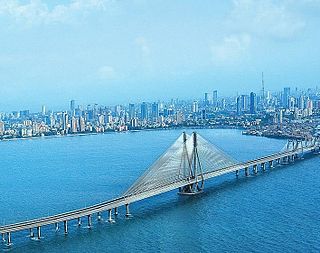
Mumbai is the capital city of the Indian state of Maharashtra. According to United Nations, as of 2018, Mumbai was the second most populous city in India after Delhi and the seventh most populous city in the world with a population of 19.98 million. As per Indian government population census of 2011, Mumbai was the most populous city in India with an estimated city proper population of 12.5 million living under Municipal Corporation of Greater Mumbai. Mumbai is the centre of the Mumbai Metropolitan Region, the sixth most populous metropolitan area in the world with a population of over 23.64 million. Mumbai lies on the Konkan coast on the west coast of India and has a deep natural harbour. In 2008, Mumbai was named an alpha world city. It is also the wealthiest city in India, and has the highest number of millionaires and billionaires among all cities in India. Mumbai is home to three UNESCO World Heritage Sites: the Elephanta Caves, Chhatrapati Shivaji Maharaj Terminus, and the city's distinctive ensemble of Victorian and Art Deco buildings.

The Bombay explosion occurred on 14 April 1944, in the Victoria Dock of Bombay when the freighter SS Fort Stikine, carrying a mixed cargo of cotton bales, gold, and ammunition including around 1,400 tons of explosives, caught fire and was destroyed in two giant blasts, scattering debris, sinking surrounding ships and setting fire to the area, killing around 800 to 1,300 people. Some 80,000 people were made homeless and 71 firemen lost their lives in the aftermath.
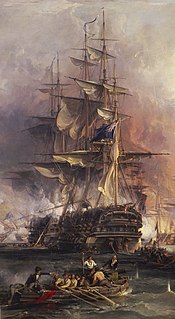
HMS Minden was a Royal Navy 74-gun Ganges-class third-rate ship of the line, launched on 19 June 1810. She was named after the German town Minden and the Battle of Minden of 1759, a decisive victory of British and Prussian forces over France in the Seven Years' War. The town is about 75 km away from Hanover, from where the House of Hanover comes—the dynasty which ruled the United Kingdom from 1714 until 1901.
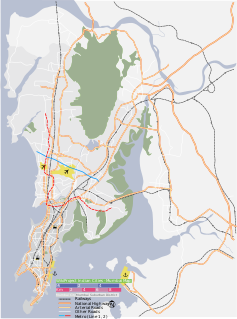
Parel or a neighbourhood of Mumbai.
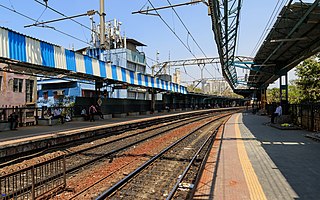
Cotton Green is a suburb of Mumbai, and a noted residential and commercial area east of Parel, in central Mumbai, 8 km north of Colaba. It is also the name of a railway station on the Mumbai suburban railway, which lies along the Harbour line, which is a part of the Central Railway.

Byculla is a neighbourhood in South Mumbai. It is also the name of a railway station on the Mumbai suburban railway on the Central Railway line.

The History of Mumbai, can be traced back to 600 BC, when evidences of the first known settlement,Harrappan Civilization, here have been discovered.
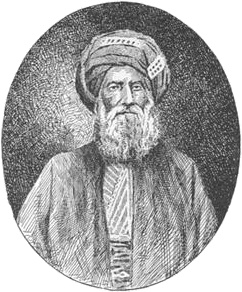
David Sassoon was the treasurer of Baghdad between 1817 and 1829. He became the leader of the Jewish community in Bombay after Baghdadi Jews emigrated there.

Castella de Aguada, also known as the Bandra Fort, is a fort located in Bandra, Mumbai. "Castella" is a misspelling for Portuguese "Castelo" (castle). Properly, it should be called Castelo da Aguada, although it seems its Portuguese builders actually called it Forte de Bandorá. It is located at Land's End in Bandra. It was built by the Portuguese in 1640 as a watchtower overlooking Mahim Bay, the Arabian Sea and the southern island of Mahim. The strategic value of the fort was enhanced in 1661 after the Portuguese ceded the seven islands of Bombay that lay to the immediate south of Bandra to the English. The name indicates its origin as a place where fresh water was available in the form of a fountain ("Aguada") for Portuguese ships cruising the coasts in the initial period of Portuguese presence. The fort lies over several levels, from sea level to an altitude of 24 metres (79 ft). Castella de Aguada has been featured in several Hindi films, such as Dil Chahta Hai and Buddha Mil Gaya.
Organised crime in India is a reference to organised crime elements originating in India and active in many parts of the world. The mafia is involved in many criminal activities based in India and international as well. The Indian mafia also refers to those powerful families that have criminal aspects to them.

Sandhurst Road is a railway station on the Central and Harbour Lines of the Mumbai Suburban Railway. It is the third stop from Chhatrapati Shivaji Terminus.
Swansea Docks is the collective name for several docks in Swansea, Wales. The Swansea docks are located immediately south-east of Swansea city centre. In the mid-19th century, the port was exporting 60% of the world's copper from factories situated in the Tawe valley. The working docks area today is owned and operated by Associated British Ports as the Port of Swansea and the northern part around the Prince of Wales Dock is undergoing re-development into a new urban area branded the SA1 Swansea Waterfront.

Bhaucha Dhakka is a wharf along the Thane Creek, along the coast of Dockyard Road on the Eastern seafront of Mumbai, the capital of the Indian state of Maharashtra. The wharf serves as the port for numerous fishermen who bring in their daily catch. Ferry services link up JNPT, Uran to the east, and Rewas and Mandwa to the south. The wharf is used by the students of the Training Ship Rahaman which is an institute for maritime studies on the island of Nhava.

Colaba Causeway, officially known as Shahid Bhagat Singh Road, is a commercial street, and a major causeway or land link between Colaba and the Old Woman's Island in the city of Mumbai, India.

The Grand Trunk steamship Prince Rupert and her sister ship SS Prince George served the coast of British Columbia and Alaska. Prince Rupert had a 45-year career serving northern ports from Vancouver, British Columbia, from 1910 to 1955. The ship was considered "unlucky" and suffered several incidents during her career, including two significant ones that left large portions of the vessel underwater. The ship was broken up in 1956.

Mumbai Port Trust is a port which lies midway on the West coast of India, on the natural deep-water harbour of Mumbai (Bombay) in Maharashtra. The harbour spread over 400 square kilometres (150 sq mi) is protected by the mainland of Konkan to its east and north and by the island city of Mumbai to its west. The harbour opens to the south to the Arabian Sea.

HMIS Bombay (J249), later INS Bombay, named for the city of Bombay in India, was one of 60 Bathurst class corvettes constructed during World War II and one of four operated by the Royal Indian Navy.
Human habitation of Mumbai existed since the Stone Age, the Kolis and Aagri(a Marathi fishing community) were the earliest known settlers of the islands. The Maurya Empire gained control of the islands during the 3rd century BCE and transformed it into a centre of Buddhist culture and religion. Later, between the 2nd century BCE and 9th century BCE, the islands came under the control of successive indigenous dynasties: Satavahanas, Abhiras, Vakatakas, Kalachuris, Konkan Mauryas, Chalukyas and Rashtrakutas, before being ruled by the Silharas from 810 to 1260.

Sassoon Docks is one of the oldest docks in Mumbai. It was the first wet dock constructed in 1875 in Bombay. It is one of the few docks in the city open to the public. It is situated in Mumbai harbor in South Mumbai area of Colaba. It is one of largest fish markets in the Mumbai city. Its neighboring features are Mumbai Port Trust Garden and Offices of Fisheries Department, and it overlooks Oyster Rock, an island in the Mumbai harbour, at a distance.

Kurla is a railway station on the Central and Harbour lines of the Mumbai Suburban Railway network. It is among the oldest railway stations in India, it being part of the original 21 mile (33.8 km) Great Indian Peninsular Railway (GIPR) section between Bombay (Mumbai) and Tannah (Thane) that opened in 1853.















